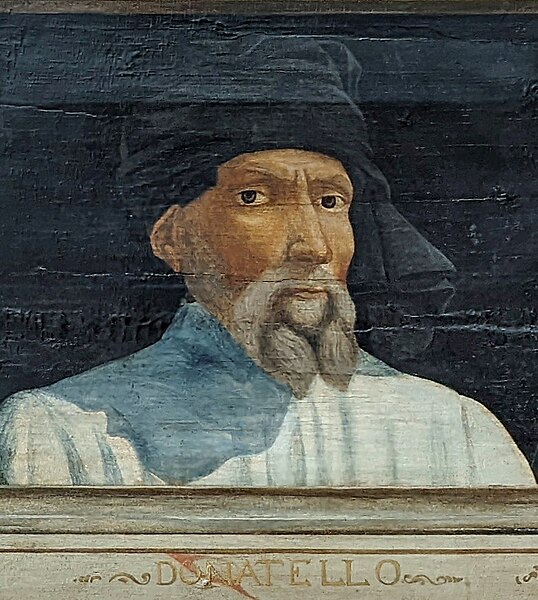
Born: c.1386, Florence
Died: 13 December 1466 (aged 79-80
Period: Early Renaissance
The Life of Donatello
Donatello, born Donato di Niccolò di Betto Bardi in 1386 in Florence, Italy, is considered one of the foremost sculptors of the Italian Renaissance. His innovative work in sculpture transformed the medium, moving it away from the Gothic style to a more classical and realistic approach that would influence the Renaissance’s development.
Donatello was apprenticed to a goldsmith early in his life, but his artistic talent soon led him to the workshop of Lorenzo Ghiberti, a prominent Florentine sculptor. Here, Donatello would have been involved in the creation of the bronze doors of the Florence Baptistery, an experience that undoubtedly influenced his mastery of bronze sculpting.
Donatello’s career was marked by the creation of groundbreaking sculptures that demonstrated his innovative use of materials such as marble, bronze, wood, and terracotta, and his mastery of both relief and freestanding sculpture. His works are characterized by their detailed humanism and the expressive realism he imparted to his figures, capturing a range of emotions and physical characteristics that had not been seen in sculpture since antiquity.
One of Donatello’s earliest masterpieces is the marble statue of “David” (1408-1409), made for the Florence Cathedral, which demonstrates his grasp of classical form. However, it is his later bronze “David” (circa 1440s), commissioned by the Medici family, that is often considered the first major work of Renaissance sculpture. This statue is notable for its unprecedented naturalism and the sensuality of its depiction of the biblical hero.
Donatello’s work was not limited to religious themes; he also produced notable sculptures of historical figures and decorative artworks. His innovative techniques, particularly in his relief sculptures, such as the “St. George” tabernacle (c. 1415-1417) and the “Feast of Herod” (1427), introduced a sense of depth and perspective that influenced the development of Renaissance art.
In his later years, Donatello continued to work on significant commissions in both Florence and other Italian cities, including Padua, where he created the equestrian statue of “Gattamelata” (1445-1450), another groundbreaking work that revived the tradition of monumental equestrian statues from the Roman era.
Donatello remained active in his field until his death in 1466 in Florence. His legacy is profound, with his innovations in sculpture influencing generations of artists, including Michelangelo and beyond. Donatello’s work marked a return to classical techniques and pushed the boundaries of artistic expression, making him a pivotal figure in the Renaissance’s artistic evolution.
Donatello’s Notable Works
Donatello, a master of Renaissance sculpture, is celebrated for his innovative approach to form, perspective, and expression. His works were groundbreaking, demonstrating a depth of emotion and realism that had not been seen in sculpture since antiquity. Here are ten of Donatello’s most famous and influential works:
- David (Bronze, c. 1440s) – This revolutionary work is renowned for being the first unsupported standing work of bronze cast during the Renaissance, and possibly the first freestanding nude male sculpture made since antiquity. It depicts the young David, a biblical hero, after his victory over the giant Goliath.
- Gattamelata (Equestrian Statue, c. 1445-1450) – Located in Padua, this is one of the first great equestrian statues of the Renaissance, reviving an ancient Roman tradition. It portrays the mercenary commander Erasmo da Narni, known as Gattamelata.
- David (Marble, c. 1408-1409) – Created early in his career, this marble statue was one of Donatello’s first major works, depicting a more conventional and clothed figure of David, with a detailed rendering of form and expression.
- St. Mark (Marble, c. 1411-1413) – Commissioned for the Orsanmichele church in Florence, this statue showcases Donatello’s skill in creating lifelike drapery and a sense of dignity in the figure’s stance.
- St. George (Marble, c. 1415-1417) – Originally created for the exterior of Orsanmichele, this statue depicts the young saint with a sense of vigor and readiness, exemplifying Donatello’s mastery of human anatomy and expression.
- The Feast of Herod (Gilded Bronze Relief, c. 1427) – This relief panel for the baptismal font of Siena Cathedral is celebrated for its use of linear perspective, a revolutionary technique at the time, which adds depth to the scene depicting the beheading of John the Baptist.
- Magdalene Penitent (Wood, c. 1453-1455) – This wooden sculpture is notable for its intense realism and expression of emotion, portraying Mary Magdalene in later life, worn and emaciated after years of penitence.
- Zuccone (Marble, c. 1423-1425) – Also known as “Pumpkin,” this statue is one of Donatello’s most striking works for its expressive realism and the intense gaze of the figure, believed to represent the prophet Habakkuk.
- Cantoria (Marble Relief, c. 1433-1438) – Created for the Florence Cathedral, this singing gallery is adorned with reliefs of dancing and singing children, showcasing Donatello’s ability to capture movement and emotion.
- Judith and Holofernes (Bronze, c. 1457-1464) – This bronze statue group, originally intended for the Medici Palace, illustrates the biblical story of Judith slaying Holofernes. It demonstrates Donatello’s skill in conveying dramatic intensity and moral complexity.
These works highlight Donatello’s versatility across different media and his pioneering contributions to Renaissance art, marking significant advancements in the portrayal of human figures and emotions.